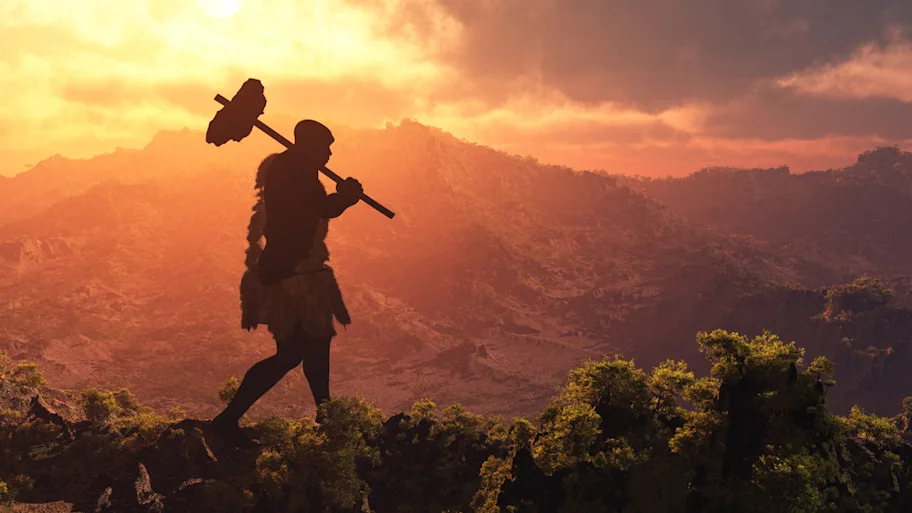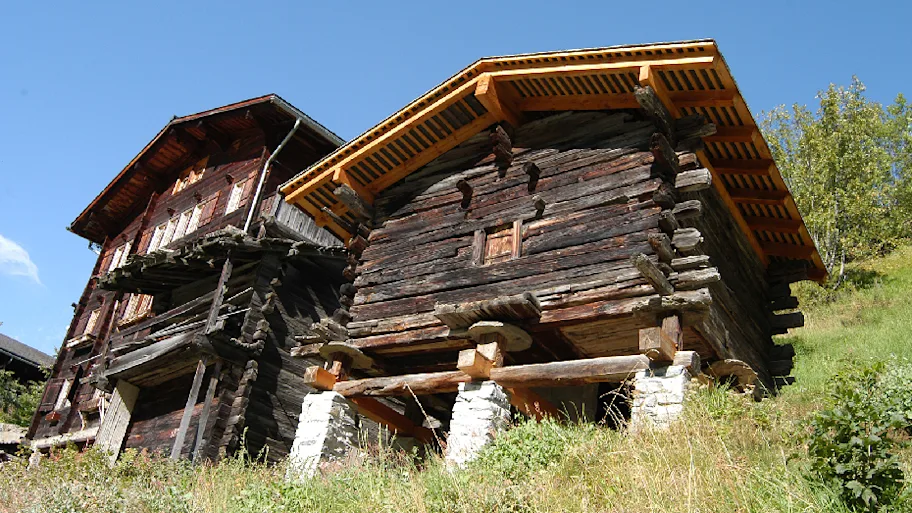
- Science News
- Featured news
- Team reveals amazing reconstructions of our ancestors to correct mistakes of the past
Team reveals amazing reconstructions of our ancestors to correct mistakes of the past
Recent collaboration between scientists and artists has produced the most accurate representations of our ancestors so far, correcting what they perceive to be ‘racist and misogynistic’ recreations of the past
By Ryan M Campbell (PhD student, University of Adelaide), Gabriel Vinas (MFA candidate, Arizona State University), Dr Maciej Henneberg (emeritus professor, Anthropological and Comparative Anatomy, University of Adelaide), and Dr Rui Diogo (associate professor, Howard University)

Pigmented silicone casts of facial reconstructions of Lucy (A) and the Taung child (B) showing different skin tones. Lucy’s tone has been reconstructed to appear more similar to that of bonobos, whereas the Taung child’s tone is more similar to that of anatomically modern humans native to South Africa. Image credit: R. Campbell, G. Vinas, M. Henneberg, R. Diogo
Reconstructions of human ancestors that inhabited the planet hundreds of thousands or millions of years ago have become increasingly popular in recent years due to a long-standing fascination with our origins. For the broader public, as well as for many scholars, the use of such reconstructions has been considered as an effective translator of scientific knowledge. However, the claim that such reconstructions provide accurate representations and a synthesis of facts about human evolution has now been seriously called into question.
In our new review study in Frontiers in Ecology and Evolution, we present the results of our long-term collaborative work dedicated to the practice of reconstruction. This is is a follow-up to a thesis produced 10 years ago by Kari Anderson of the University of Adelaide who, along with Dr Maciej Henneberg, identified major methodological problems concerning how most reconstructions have been done in the past. Our new paper expands on that work, being the first of its kind to provide a formal survey and systematic analysis of the literature about this topic and a discussion of its broader artistic and societal implications.
We believe that the article will be valuable as a guide to all those involved in the detailed and exciting work of reconstructing the appearances of our ancestors. The research findings will also be of great interest to those members of the general public that want to know more about our evolutionary past. Indeed, doing more thorough scientific reconstruction studies that are chiefly based on the available empirical data instead of a priori biases and assumptions is something that is absolutely needed in order to have a proper understanding of our lineage and, ultimately, a better grasp on what it means to be human.

Two facial reconstructions of the Taung child (without hair and pigment) that were produced one year apart. Please note how variability between these reconstructions is exemplified by the subjective decision to depict the subject as more apelike (A) or more humanlike (B). Image credit: R. Campbell, G. Vinas, M. Henneberg, R. Diogo
‘Gross discrepancies’ in previous models
We provide a comprehensive review of the evidence and methods used to build such reconstructions, from the early 19th century to modern-day forensic and computer-based methods. Our research findings show that reconstructions have been largely unchallenged by the scientific community and displayed in museums with very little empirical evidence to support them. Worse still, by attempting to produce their own reconstructions of our ancestors, the authors have found most methods of reconstruction irreplaceable. We conclude that this is the cause for the gross discrepancies they have identified between reconstructions of the same individual displayed in various media.
Download original article (pdf)
Ryan M Campbell: “I first became interested in reconstructing hominids after I saw the Lucy exhibit at the ‘Answers in Genesis’ Creation Museum in Petersburg, Kentucky. Upon comparing this reconstruction of Lucy with her many other reconstructions around the world, I was shocked to find that they all looked very different. I expected to find consistency in those reconstructions displayed in natural history museums, but the differences, even there, were so severe that I almost thought all previous practitioners had never encountered a single hominid reconstruction before commencing their own.”
‘I expected to find consistency in reconstructions … but the differences were so severe I almost thought all previous practitioners had never encountered a single hominid reconstruction before’
Ryan M Campbell
Gabriel Vinas, the artist who handles the sculptural phase in the lab says: “It seems that the general public, and in many cases the scientific community, are readily taken in by the apparent realism of a reconstruction without questioning its validity. We have assumed validity of a process before questioning artists as to how they validate the reliability of their methods, the applicability of their data, or even how they produce and publish data at all.
“Our work shows that methods for achieving scientifically justified reconstructions are still not quite in our grasp, despite what many artists and institutions readily advertise. Be that as it may, I prefer to continue work in the service of developing new reliable methods rather than perpetuating erroneous, albeit culturally accepted, reconstructions based on unscientific methods and biased misconceptions.”

An intuitive reconstruction of Lucy’s soft tissues (without hair and pigment) produced in 2018 and reconstructed over the digitally reconstructed A.L. 288-1 skeleton published in Brassey et al. (2018). Image credit: R. Campbell, G. Vinas, M. Henneberg, R. Diogo
Following imaginary tales
In addition, the publication also provides a review of the broader societal implications of presenting visual depictions of hominids that are not based on strong scientific foundations. “Actually, many of the previous reconstructions have been highly influenced by imaginary tales about what is ‘primitive’ and ‘savage’, versus what is ‘civilized’ and ‘modern’,” says Dr Rui Diogo. “[This] is a longstanding dichotomy that is often designated in the literature as the ‘Hobbes versus Rousseau debate’ and that has made it particularly difficult to discuss such subjects in an unbiased way in the past.
“One example I discuss at length in my new book is how many depictions of Lucy tend to show her alone in the wide savannah with her ‘husband’ and 1 or 2 children, while the empirical data available tell us that such a concept of a small nuclear family is actually a very recent construction of human history. Such biases and stereotypes are moreover particularly relevant because they are profoundly related to longstanding constructed narratives about our ‘cosmic purpose’ and about ‘progress’, which are in turn deeply linked to racist and misogynistic ideas and tribal concepts.”
‘Many previous reconstructions have been highly influenced by imaginary tales about what is ‘primitive’ and ‘savage’, versus what is ‘civilized’ and ‘modern’’
Dr Rui Diogo
“Earlier reconstructions are heavily biased by opinions of their creators,” says Dr Maciej Henneberg. “These opinions are based on changing interpretations of the fossil record. It is normal for researchers to present different conclusions drawn from their studies of the same fossil evidence during an ongoing scientific debate, however, casting specific views in stone of a complete reconstruction does not reflect the debate, just one of many interpretations.
“The end result is that a particular reconstruction of a specific fossil may present it as a quadrupedal creature in one museum, while another reconstruction of the same fossil in a different museum portrays it as an erect bipedal person. Taking the average – a three legged individual – is not an option.”

Digital model of the _Australopithecus afarensi_s composite male cranium reconstructed in Kimbel et al. (1984) and Kimbel and White (1988) (A). Mandible belonging to the A.L. 288-1 (Lucy) partial skeleton (B). Reconstruction of Lucy’s skull that was produced by scaling the male cranium to fit the A.L. 288-1 mandible (C). Image credit: R. Campbell, G. Vinas, M. Henneberg, R. Diogo

A facial reconstruction of Lucy (without hair and pigment) produced in 2019 that employed facial soft tissue regression models developed in Simpson and Henneberg (2002) from modern human material. Image credit: R. Campbell, G. Vinas, M. Henneberg, R. Diogo

Digital models showing the progression of the facial reconstruction procedure. Subject is based on a reconstruction of the Neanderthal Amud 1 cranium and associated mandible originally reconstructed by Suzuki and Takai (1970). Facial soft tissues were reconstructed using regression models developed in Simpson and Henneberg (2002) from modern human material.

Facial reconstruction of Amud 1 (without hair and pigment) produced in 2019 that employed facial soft tissue regression models developed in Simpson and Henneberg (2002) from modern human material. Image credit: R. Campbell, G. Vinas, M. Henneberg, R. Diogo

A marble sculpture titled “Santa Lucia” carved in 2019 following the body-composition of the intuitive reconstruction of Lucy from 2018 shown above. Image credit: R. Campbell, G. Vinas, M. Henneberg, R. Diogo
If you have recently published a research paper with Frontiers and would like to write an editorial about your research, get in touch with the Science Communications team at press@frontiersin.org with 'guest editorial' in your subject line.
REPUBLISHING GUIDELINES: Open access and sharing research is part of Frontiers’ mission. Unless otherwise noted, you can republish articles posted in the Frontiers news blog — as long as you include a link back to the original research. Selling the articles is not allowed.






